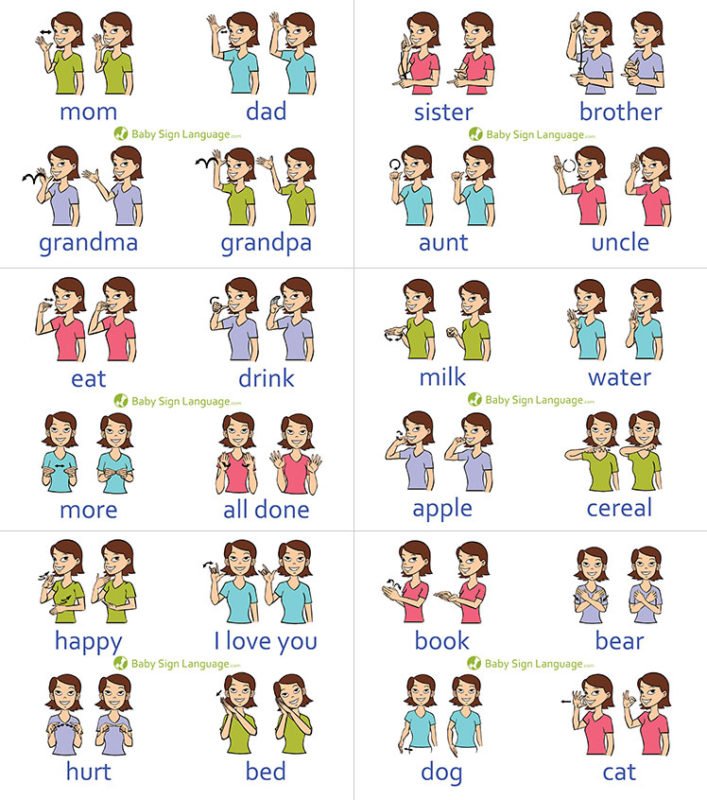As babies get older, they ramp things up in the expressive language department. They start with cooing, graduate to babbling, and then add words. By the 1-year mark, babies are usually able to say “Mama” and “Dada” specifically (i.e. to the proper people) plus one other word (such as “ball”).
Below are 7 Ways to Support Your Baby’s Language Development
1. Be a Narrator. Describe everything that you’re doing out loud. For example, if you’re folding a shirt, you can say “I’m folding your green shirt before I put it in your closet.” You may feel a little silly doing this, but trust me, your baby is hanging on your every word.
2. Validate What Your Baby is Saying. If your baby throws a bunch of babbles at you, turn your body towards him/her and listen. Then respond by nodding and smiling or repeating whatever you think he/she was trying to say. Babies want to be “heard” even if you can’t understand a word (or a syllable) of what they’re saying.
3. Act as a Translator. Babies communicate through gestures and facial expressions as well as through words. Teach your baby the words that go along with these other forms of communication. For example, if your baby raises his/her arms to be picked up, you can say “You’re raising your arms. Do you want me to pick you up?” Or, if your baby gets excited when you give him/her a food that he/she likes, you can say “You look excited to eat. I think bananas are one of your favorite foods.”
4. Sing (Even if You Suck At It). Singing is a great way to make language fun. Songs that rhyme and repeat help kids cement words in their minds.
5. Play Games. Children tend to love anything that’s gamified. So, play peek-a-boo and pat-a-cake and talk the entire time.
6. Keep it Light. Although parents are often eager to hear their baby say new words, babies operate on their own schedule and don’t appreciate feeling pressured to say (or do) things before they’re ready. Even though they’re young, babies can sense their parents’ energy around things. So be chill and keep things positive and pressure-free.
7. Try Baby Sign Language:
During the toddler years, you may notice that your child has a lot to say but is limited by the words that he/she knows. This can be super frustrating for kids and is one of the main reasons temper tantrums occur. What may sound like gibberish to you is actually a full-on sentence in your toddler’s mind.
Speech therapists often recommend (to varying degrees) that parents add baby sign language to the mix to give their baby another way to communicate while he/she builds up his/her vocabulary. Baby sign language is particularly helpful for kids with speech delays.
Below is a Chart of the Top 24 Baby Sign Language Gestures (Courtesy of BabySignLanguage.com).
PediaTip: My advice is to start with 3-5 signs, so you don’t get overwhelmed. Popular initial signs include “eat,” “drink,” “milk,” “more,” and “all done.” The goal is not for your child to become “fluent” in baby sign language, but to teach him/her a handful of signs to help bridge the communication gap early on.

Image Source: BabySignLanguage.com
Common Question: Should I Talk “Baby Talk” to My Baby?
We’ve all heard parents in the grocery store, on planes, and in toy stores talk to their babies in the somewhat grating sing-song voice of baby talk. We’ve probably all been that parent at one time or another too…gasp!

So, the question remains, does baby talk help or hinder language development?
Although the research is still cooking, the prevailing thought seems to be that “Yes! Babies benefit from baby talk.”
But How Can Something So Annoying Be So Beneficial? Researchers believe that when parents slow the pace of their speech and use an exaggerated intonation, the vowels and consonants sound clearer and are easier to differentiate. In addition, babies are more captivated by a lilting baby talk voice than by an everyday “normal” voice.
The Exception? Nonsense words do NOT help build a child’s language, so refrain from using them (if you can).
So, the next time you hear another parent (or yourself) engage in baby talk, know that researchers give it the thumbs up (for now).
The Bottom Line
Use the tips above to encourage your child’s language development and teach your little one a few signs to make it easier for him/her to express him/herself.





